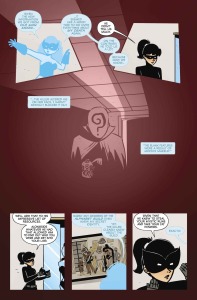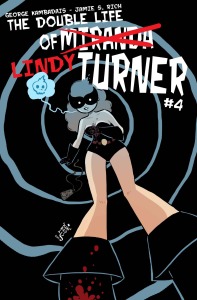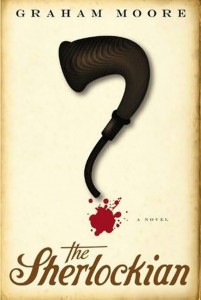(Jamie S Rich/George Kambadais; 17 pages, digital; MONKEYBRAIN COMICS, 2014)
Artist George Kambadais had an idea; he contacted writer Jamie S Rich with details of his idea. A young woman named Lindy Tuner has been murdered, in her superhero garb, as the Cat. Lindy’s spirit visits her younger sister Miranda, who, after digesting the fact that her sister was a superhero and… a dead one, at that, decided to pick up the mantle, hoping to give her sister justice. Rich was intrigued and, a few months later, the first issue of THE DOUBLE LIFE OF MIRANDA TURNER was published by digital comics pioneers, Monkeybrain Comics.

Actually, now four issues into the series, this “origin” story takes center stage, as Miranda, with help from Lindy, closes in on the killer. To catch you up, the first issue was kind of a meet and greet, as we’re introduced to novice costumed hero Miranda, in mid-battle with a couple of super-baddies, part of a group known as the Blockheads. The Cat is up to her ears in toy building blocks (sorta like Legos) but, refusing her ghostly sibling’s aid, she works her way out of the problem. Unfortunately, she loses the bad guys along the way. The second and third issues, a two-parter called “If You Have Ghosts,” lays the official groundwork for this issue. These stories are fast-paced, exciting and a really fun read, written to appeal to everyone, aged twelve and up… especially girls. I’m not sure if it’s the subject matter or merely Kambadais’ stylistic art but, I find myself making comparisons to the old Hanna-Barbara Saturday morning cartoon, JOSIE AND THE PUSSYCATS; it’s sort of an odd style that evokes the work of the great comics and cartoon artist, Alex Toth (who designed characters and backgrounds for most H-B shows in the ’60s, including JOSIE… ), and the artistic team responsible for the amazing look of another animated series, SAMURAI JACK.

Kambadais is a master of odd angles and perspectives, as well as an overall intriguing page design; he, like Toth, does so very much with so few lines, allowing his color art (or, as on the “If You Have Ghosts” issues, the excellent color designs of Paulina Ganucheau) to do much of the heavy work. Rich, for the most part, never over-scripts; he seemingly manages to cram two or three pages of exposition into a panel or two… sometimes, in a line or two. To be sure, the premise of …MIRANDA TURNER isn’t a new one. Ghosts, spirits and mysticism of some sort have been a part of comics pretty much since that very first issue of ACTION COMICS (you know the one… the one that starred Zatara, Master Magician and that guy in the red cape and drawers): Deadman, the Spectre, Ghost Rider, Solomon Grundy and – DUH! – the Spirit, among about a jillion others. The difference here is the kitschy slumber party feel of the sisters’ relationship, a sibling rivalry that runs deep, even in death… until someone else starts messing with one or the other. Miranda is determined to find Lindy’s killer while forging her own path as the Cat; Lindy is determined to keep Miranda safe while helping her find the answer to her own murder. I must say that, so far, the experience has been a very pleasant surprise, especially for a guy who’s been reading comics since the early 1960s.

If there’s a pre- or early teen girl in your circle of influence, particularly those interested in Manga or Anime, you could certainly do worse than introducing them to THE DOUBLE LIFE OF MIRANDA TURNER. My only complaint is that, in the nearly two years since the debut issue, there have (obviously) only been three more issues published and… well, that twist ending at the end of this issue has me looking for the next installment, like, NOW! All four issues of this great series, as well as the entire Monkeybrain digital library, are available for purchase (99¢ each) at comixology.com; you can check out previews of this and other books at monkeybraincomics.com. There are plenty of titles suitable for every age group. Monkeybrain is the perfect introduction to comics for kids of all ages.


















